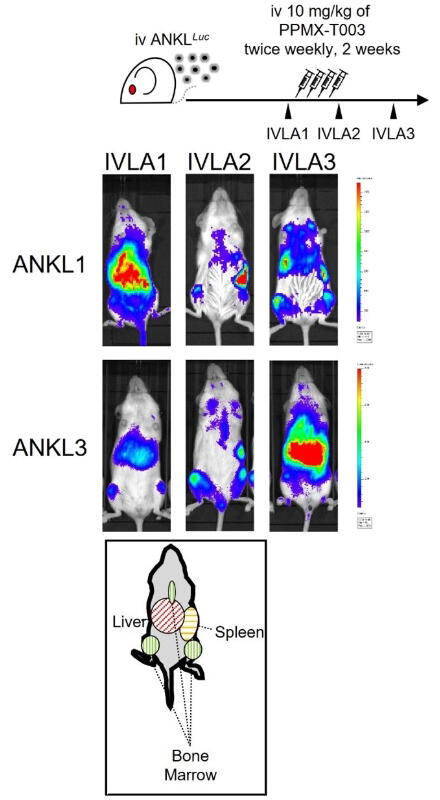A research group led by Specially Appointed Assistant Professor Ryo Yanagiya and Professor Ai Kotani of the Research Institute for Microbial Diseases at Osaka University, in collaboration with Tokai University and other institutions, has announced that they identified a factor required for the therapeutic effectiveness of PPMX-T003. This anti-transferrin receptor 1 (TfR1) inhibitory antibody shows potent therapeutic efficacy against aggressive natural killer cell leukemia (ANKL), a rare disease with a poor prognosis. Single-cell RNA sequencing revealed that the amino acid transporter "LAT1" was expressed at high levels, specifically in the treatment-sensitive cell population. The results showed that "LAT1" expression could be used as a marker to predict the therapeutic efficacy of the antibody. The study was published in the June 24 issue of the international journal Leukemia.

Provided by Osaka University
ANKL is an intractable hematological malignancy that affects young adults in Asia, including Japan, and also South America. It has an extremely poor survival prognosis with a median survival of less than 51 days. Only 11.2 patients are registered annually in Japan, making it difficult to advance the development of treatment methods. No standard treatment has been established. The only drug proven effective to date is an anticancer drug (L-asparaginase). However, it places a heavy burden on the liver, which hampers its early administration at sufficient doses to patients with this disease who present with severe liver injury at the time of disease onset.
Previously, the research group has successfully generated an ANKL model by transplanting human ANKL cells into immunodeficient mice. They have shown that ANKL cells proliferate in the capillaries of the liver "sinusoid," that the iron transport protein "transferrin" is essential, and that administration of the anti-transferrin receptor inhibitory antibody PPMX-T003 to the model mice shows very high therapeutic efficacy (marked weight regain and prolonged survival). Currently, they are conducting an investigator-initiated multicenter clinical trial. Meanwhile, the mechanism underlying the observed therapeutic effectiveness remained largely unclear.
In this study, the research group noted that ANKL cells in extrahepatic organs, particularly those in the spleen, in PPMX-T003-treated model mice were resistant to treatment and relapsed as the drug decreased, while liver-resident ANKL cells were highly sensitive to treatment. They focused on the microenvironment and aimed to identify factors necessary for therapeutic efficacy. Using single-cell RNA sequencing, which allows for analysis of all genes expressed in the cells in a specimen, they found a subpopulation of cancer cells whose number was significantly reduced after treatment (treatment-sensitive cell population). The LAT1 gene was found to be highly expressed in this cell population. LAT1 is an amino acid transporter gene, and this result indicates that an influx of a large amount of extracellular amino acids is required for treating the sensitivity of the cells. PPMX-T003 induces apoptosis of cancer cells by degrading their DNA. Therefore, they tested the effect of PPMX-T003 in cultured cells using DNA damage as an indicator and confirmed that the effect was attenuated by an LAT1 inhibitor.
Next, they confirmed that the effectiveness of PPMX-T003 treatment was reduced by an LAT1 inhibitor in model mice. LAT1 is very limitedly expressed in normal cells, with some exceptions, such as the placenta. The ongoing investigator-initiated clinical trial is expected to validate the safety and efficacy of PPMX-T003 and prolonged survival. If survival can be prolonged, it opens the possibility that subsequent bone marrow transplantation can be chosen.
Yanagiya said, "ANKL cells proliferate in the sinusoid, in which highest blood levels of amino acids and other nutrients are found in the human body because sinusoidal capillaries are located immediately before where food-derived nutrients from the digestive tract are taken up by the liver. We found that when abundant amino acids are taken up via LAT1 to the entire body, the proliferative activity of cancer cells becomes extremely high. This study shows that efficient amino acid influx into tumor cells via LAT1 to turn on the proliferation switch is important for the therapeutic effectiveness of PPMX-T003, suggesting the potential of LAT1 as a predictor of the treatment responsiveness."
Kotani said, "ANKL is a rare hematological malignancy, and some physicians, even in hematology, do not know about it. We hope this disease and the ongoing investigator-initiated clinical trial become more widely known."
Journal Information
Publication: Leukemia
Title: Amino acid influx via LAT1 regulates iron demand and sensitivity to PPMX-T003 of aggressive natural killer cell leukemia
DOI: 10.1038/s41375-024-02296-6
This article has been translated by JST with permission from The Science News Ltd. (https://sci-news.co.jp/). Unauthorized reproduction of the article and photographs is prohibited.




